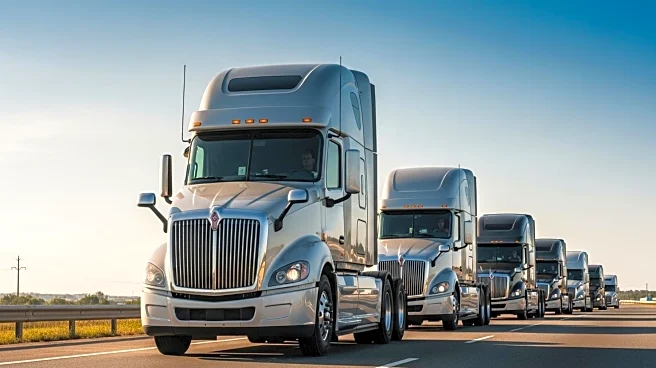What's Happening?
President Trump has announced a new wave of tariffs, including a 25% duty on heavy-duty trucks imported into the United States. This tariff, effective October 1, marks a significant shift from the previous 0% duty on these imports. The decision is part of a broader tariff strategy that also includes a 50% tariff on household goods, a 30% tariff on upholstered furniture, and a 100% tariff on pharmaceutical products if the company does not have a manufacturing plant in the U.S. These measures are expected to impact freight demand and economic conditions in the trucking sector, which has been recovering from a freight recession. Industry analysts warn that these tariffs could reverse recent improvements in freight rates and volumes, prolonging economic uncertainty.
Why It's Important?
The imposition of tariffs on heavy-duty truck imports is likely to have significant repercussions for the U.S. trucking industry. With approximately 35% of medium- and heavy-duty commercial vehicles in the U.S. being imported, the increased costs could lead to higher prices for truck buyers and fleets. This move may compel major truck manufacturers to shift production to the U.S. to mitigate tariff impacts, potentially creating domestic jobs. However, the trucking industry is already facing challenges such as rising costs and soft freight volumes, and these tariffs could exacerbate these issues. The American Trucking Associations (ATA) has expressed concerns about the potential impact on truck prices and the broader economic environment.
What's Next?
In response to the tariffs, major truck manufacturers like Daimler, Paccar, Volvo, and Traton may consider relocating production to the U.S. to avoid the tariffs. The ATA is assessing the impact of these tariffs and has suggested that relief could come if the Trump administration revises the low NOx rule or removes the federal excise tax, which adds 13% to heavy-duty commercial equipment costs. The industry will be closely monitoring these developments and their effects on truck prices and fleet operations.
Beyond the Headlines
The tariffs could lead to long-term shifts in manufacturing strategies, with companies potentially increasing U.S. production to avoid import duties. This could align with the administration's goal of revitalizing U.S. manufacturing and creating domestic jobs. However, the immediate impact on the trucking industry could be challenging, as fleets may face increased costs and economic uncertainty.











